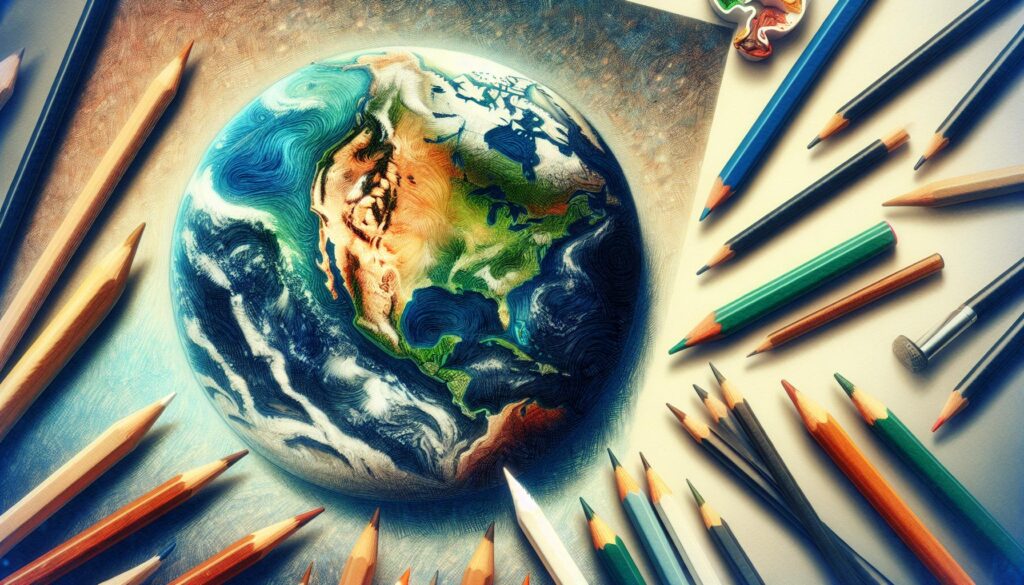Drawing:bvqrlbilqxy= Earth is more than just putting pencil to paper; it’s about capturing the beauty and complexity of our planet. I’ve always been fascinated by the intricate details that make up our world, from the vast oceans to the towering mountains. Each stroke reveals a story that connects us to nature and inspires creativity.
In this article, I’ll explore various techniques and tips to help you draw the Earth with confidence. Whether you’re a beginner or an experienced artist, there’s always something new to learn. Join me as we dive into the art of depicting our beautiful planet and discover how to bring your vision to life on the canvas.
Key Takeaways
- Artistic Techniques Matter: Mastering observational skills, layering, and texture creation is essential for effectively drawing Earth’s diverse landscapes.
- Choose the Right Tools: Utilize various tools like graphite pencils, markers, and digital software to enhance your artistic expression.
- Inspiration from Nature: Engaging in nature walks and attending art exhibitions can significantly inspire your artistic journey and improve your drawing skills.
- Cultural Perspectives: Artists’ diverse backgrounds influence their interpretations of Earth’s beauty, promoting a richer understanding of global environmental issues.
- Environmental Awareness: Drawing:bvqrlbilqxy= earth serve as a platform for raising awareness about climate change and ecological themes, encouraging responsible environmental practices.
- Digital Engagement: Leveraging digital formats amplifies the reach of your artwork, facilitating discussions and connections within the environmental art community.
Drawing:bvqrlbilqxy= earth
Drawing the Earth involves more than just replicating its physical features; it captures the essence of its landscapes and ecosystems. Artists often focus on significant elements like oceans, mountains, deserts, and forests. Each feature presents unique challenges and opportunities for expression.
Techniques for Drawing Earth Features
- Observational Skills
Observational skills enhance the accuracy of representations. Artists should study photographs or nature directly to understand proportions and colors. - Layering Techniques
Layering techniques, such as using colored pencils or watercolors, add depth. These methods create a realistic feel, reflecting the diverse textures found on Earth. - Creating Context
Creating context in drawings enhances storytelling. Including elements like wildlife or weather can convey a specific mood or time of day.
Tools for Earth Drawing
- Graphite Pencils
Graphite pencils provide versatility. They allow for detailed sketches and varying tones to depict shadows and highlights effectively. - Markers
Markers offer vibrant color choices. They allow for quick application and bold lines, suitable for representing vivid scenes of Earth. - Digital Software
Digital software expands possibilities. Programs provide tools for manipulation and enhancement, letting artists experiment with colors and compositions easily.
- Nature Walks
Nature walks serve as excellent inspiration. Observing different terrains and climates provides real-life reference material. - Artistic Challenges
Participating in artistic challenges can spark creativity. These challenges often encourage artists to explore specific themes or techniques related to Earth’s features. - Visiting Art Exhibitions
Visiting art exhibitions can ignite new ideas. Viewing various artistic interpretations of Earth enriches one’s understanding and approach to capturing these landscapes.
This exploration highlights the importance of technique, tools, and inspiration in drawing the Earth. Each artist’s approach contributes to a deeper connection with our planet’s beauty.
Key Features of the Drawing
Capturing the Earth’s beauty in drawings involves a combination of artistic techniques and thoughtful use of colors. Each feature adds depth to the artwork, enhancing its connection to nature.
Artistic Techniques Used
I employ various artistic techniques when drawing the Earth to accurately represent its landscapes.
- Observational Skills: I prioritize keen observation to capture the true essence of mountains, oceans, and forests.
- Layering: I use layering techniques to create depth, giving my drawings a three-dimensional feel.
- Texture Creation: I add texture using cross-hatching or stippling methods for realism, particularly in rocky surfaces or foliage.
- Blending: I blend colors and values to smooth transitions, especially when depicting skies or seamless landscapes.
These techniques contribute to a more dynamic representation of Earth’s diverse environments.
Color Palette and Themes
I select color palettes that reflect the vibrancy and diversity of Earth.
- Natural Colors: I often use earth tones—greens, browns, and blues—to depict natural landscapes.
- Seasonal Themes: I adjust colors to represent different seasons, utilizing bright hues for summer landscapes and muted tones for winter scenes.
- Atmospheric Effects: I explore atmospheric effects by incorporating gradients and varying intensities to show time of day, like warm oranges during sunsets.
These choices not only enhance the visual appeal but also evoke emotional responses connected to Earth’s beauty.
Critical Analysis
The art of drawing the Earth garners significant attention and varying perspectives within the art community. I explore these insights along with comparisons to other similar works.
Reception by the Art Community
The art community has embraced Earth drawings, recognizing their ability to evoke emotions and highlight environmental themes. Critics appreciate the blend of artistic skill and ecological awareness that many artists demonstrate. For instance, exhibitions featuring Earth-inspired art often realize increased attendance, reflecting widespread interest. Collectively, these works encourage conversations about nature and climate change, drawing attention to Earth’s fragility. Positive reviews also emerge from art critics who recognize how these pieces combine aesthetics with responsibility, reinforcing the artists’ role in environmental advocacy.
Comparison with Similar Works
When examining drawing:bvqrlbilqxy= earth, it’s vital to compare them with similar expressions found in landscapes, abstract forms, and even digital art. Traditional landscape paintings, while often idealized, capture scenes without the same emotional depth that contemporary Earth drawings often achieve. Abstract interpretations may emphasize color and form but sometimes lack the specificity and detail that resonate with viewers engaged in reality. Digital art adds another dimension, as software can enhance realism and manipulate features, yet it can compromise the organic feel present in hand-drawn works. By contrasting these forms, I find that distinct approaches to Earth representation help clarify the unique attributes inherent to drawing, emphasizing its rich narrative and emotional storytelling potential.
Implications of the Drawing
Drawing the Earth carries significant implications for artists and the audience alike. Creating these representations fosters a deeper appreciation for the planet’s beauty and complexity. Each piece acts as a reflection of the environment, inviting viewers to engage with ecological themes and the fragility of nature.
Artists often find themselves inspired to address environmental issues through their work. By depicting the Earth’s landscapes, they raise awareness about climate change, deforestation, and pollution. These drawings serve as a call to action, encouraging viewers to consider their impact on the environment.
In addition, drawings of the Earth promote cultural perspectives and diverse viewpoints. Artists from different backgrounds share their interpretations, influenced by unique experiences and landscapes. This cultural exchange enriches the artistic community and broadens understanding of global environmental issues.
Moreover, drawing the Earth can inspire future generations of artists. When young creators see the beauty captured in these artworks, they might feel motivated to explore their artistic talents. This contributes to a cycle of creativity and environmental consciousness.
Finally, the integration of technology in Earth drawings enhances their reach and engagement. Digital formats allow for sharing on social media platforms, increasing visibility and sparking discussions around environmental art. Through these digital channels, artists connect with a broader audience, expanding the impact of their work on environmental awareness.
Technology in Earth Drawings
Drawing:bvqrlbilqxy= earth is more than just an artistic endeavor; it’s a journey that connects us with the planet’s beauty and complexity. Each stroke of the pencil or brush brings us closer to understanding our environment and the challenges it faces. Through my own experiences and observations, I’ve found that these drawings not only capture landscapes but also evoke emotions and provoke thought about our ecological responsibilities.
As I continue to explore and refine my techniques, I’m inspired by the stories each drawing tells. I hope my insights encourage you to pick up your tools and express your unique vision of Earth. Let’s celebrate our planet through art and inspire others to appreciate its wonders and fragility.



